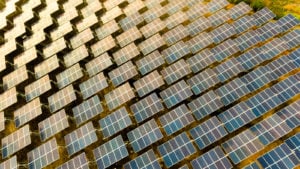The solar market in 2023 is facing a tough challenge from the relatively lower oil and natural gas prices that have made fossil fuels more attractive for power generation. The global demand for solar energy has slowed down, and many solar companies are struggling to maintain their profitability and growth. Some of them are even waving massive red flags that indicate they are in trouble and their stocks are likely to continue declining in the near and medium term. Here are three solar stocks that investors should avoid or sell in September 2023.
Altus Power (AMPS)

Altus Power (NYSE:AMPS) is a commercial-scale provider of photovoltaic energy generation systems that has been facing declining earnings and profitability margins despite experiencing higher year-over-year (YOY) revenue growth. In their second-quarter earnings print, Altus generated $46.5 million in revenue, which represented an 87.8% increase on the same period last year. Operating margins also slightly improved from 22.1% in Q2 2022 to 25.8% in Q2 2023. However, there was a significant YOY decline in net income. For the first half of 2023, Altus has only made $12.4 million in total net income versus $84.5 million in the first half of 2022. This represented a stark YOY decline in net income of 71.7%.
The reason for the reduction in earnings was, in part, due to higher depreciation costs related to the enlargement of the company’s solar energy facilities. On the surface, this probably does not come off as negative, but a severe decline in earnings due to robust top-line growth could also be a product of Altus Power not managing operating costs well. Altus’s shares are trading at 34.8x forward earnings, which is expensive and could trigger devaluation events in the near term as traders reassess the high valuations stocks have landed upon this year.
Maxeon Solar Technologies (MAXN)

Maxeon Solar Technologies (NASDAQ:MAXN) is another solar panel manufacturer that has historically suffered from low margins and cash flow problems. In 2022, the company began to improve margins slightly on a YOY perspective. This year, Maxeon Solar was able to grow revenues substantially while also generating positive EBITDA in both the first and second quarters. In particular, the solar panel manufacturer reported $49.7 million in EBITDA in Q1 and $27.9 million in Q2, which marked immense gains over the EBITDA losses of previous years.
Unfortunately, bottom-line profits have been hit or miss. The first quarter saw Maxeon post record net income while the second quarter saw the solar company’s bottom-line figures slip back into loss territory. Maxeon Solar’s management team announced a cut to revenue guidance for 2023 due to lower demand. Lower customer demand could ultimately hurt Maxeon Solar’s cost reduction initiatives and generate less net income for shareholders in the long run. Maxeon Solar’s stock has plunged by 21.1% in the past year, and while the solar company faces a bleak outlook, investors ought to steer clear.
SunPower Corporation (SPWR)

SunPower Corporation (NASDAQ:SPWR) is s solar manufacturer I have made positive comments about in the past. However, the deteriorating economic outlook and the U.S. Federal Reserve’s signal that it is willing to keep rates higher for longer have made me reconsider my position on how much SPWR can appreciate in value in the near term. To quickly recap, SunPower is a leading manufacturer of high-efficiency solar panels and systems with a diverse customer set that covers residential, commercial, and utility-scale end-markets.
SunPower has successfully grown revenue and earnings over the past two years. In 2022, in particular, the company reported revenue of $1.7 billion, up 54% YOY, and adjusted earnings per share of $0.59, up 1861% YOY. However, compared to last year’s quarterly results, YOY revenue growth in 2023 has severely compressed. Sure, the selling environment is difficult because consumers and businesses alike are increasingly more risk averse amidst the ongoing economic uncertainty. Energy prices in the United States falling from last year’s highs have also hurt demand for solar products across the board.
Nonetheless, what makes SunPower hard to recommend again — for now, at least — is the company’s high valuation, which sits at 48.1x forward earnings, and high debt level, which has settled at $347.9 million as of June 30th and is mostly floating rate. These aspects are definitely red flags and could weigh on SunPower’s shares in the short and medium term.
On the date of publication, Tyrik Torres did not hold (either directly or indirectly) any positions in the securities mentioned in this article. The opinions expressed in this article are those of the writer, subject to the InvestorPlace.com Publishing Guidelines.
